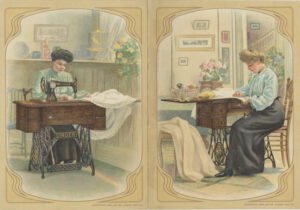
The sewing machine, beloved by stitching hobbyists and home fashionistas, was invented by French tailor Barthelemy Thimonnier. In 1830 he patented a mechanical device that could produce a simple chain stitch that would allow uniforms for the French army to be mass produced, rather than sewn by hand. Thimonnier’s innovation was not well-received. Realizing mechanized sewing was a threat to their livelihood, 200 tailors ransacked Thimonnier’s factory and destroyed his sewing machines. Thimonnier decided to make himself scarce and left town.
Given the French experience, when American Walter Hunt came up with a machine that could do both forward and back stitches, he declined to seek a patent citing concerns that such a machine could result in massive unemployment.
Enter Elias Howe — Inventor
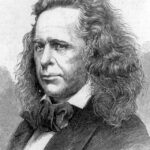
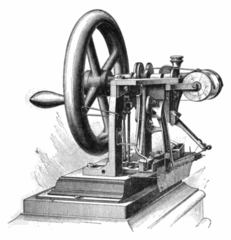
Howe worked for a Boston machinist who observed that anyone who created a practical sewing machine would get rich. Say no more. Howe spent the next eight years tinkering with a design until he developed a lock stitch that was stronger than Thimonnier’s chain stitch. Howe’s invention could “sew” 250 stitches per minute. Unfortunately, the price tag was $300, a substantial sum in 1846.
Nevertheless, on Sept. 10, 1846 Elias Howe patented the first practical sewing machine. Howe never brought his invention to the mass market, but his machine did inspire Isaac Merritt Singer, sometime actor and impresario.
Isaac Merritt Singer — Marketer
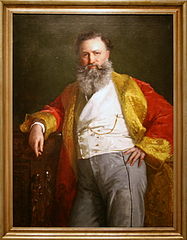
Enter Isaac Merritt Singer took side jobs while pursing an acting career. One of these was in a machine shop. By chance, someone brought in a sewing machine for repair. Singer was intrigued. It took him eleven days to construct a better sewing machine. In 1851 Singer took out a patent for his improved sewing machine with a circular feed wheel, thread controller, and power using gear wheels and shafting. Singer took in two partners, founded I. M. Singer & Company, and began manufacturing his sewing machine.

In 1854, Howe sued Singer for patent infringment and won. Singer had to pay Howe royalties on each machine he sold. Between 1854 and 1867 Howe received about $2 million in royalties.
Once the lawsuit was settled, Singer switched gears from inventor to boisterous entrepreneur. He took his sewing machine on barnstorming tours and demonstrated it as part of entertainments he held at fairs and hired halls. In 1855 Singer took his invention to Europe where he won first prize at the Paris World’s Fair.
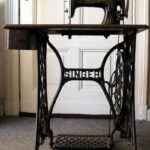
But that’s not all. Many people – I’m guessing mostly men – thought women were too incompetent to work such a machine. So, Singer hired women to demonstrate his product. It took 14 hours for a woman to sew a man’s shirt by hand; with the Singer sewing machine, it took 1 hour and 16 minutes to sew the same shirt. It was a true marvel But wait, there’s more. Singer realized price would be a sticking point, so he developed hire-purchase deals allowing customers to buy the machine in monthly installments.
The Sun Never Sets on a Singer Sewing Machine at Work

Not to mention . . .
In 1867 Singer opened a factory in Glasgow, making it the first overseas company in the world. As indicated on this sheet music for The Merry Singer [compliments of the Singer Manufacturing Company] Singer sewing machines were available in London, Cape Town, Yokohama, and Melbourne. In addition to Portugal, Zululand, and Ceylon.

Portugal, 1893 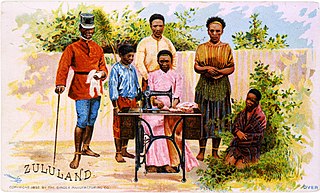
Zululand, 1893 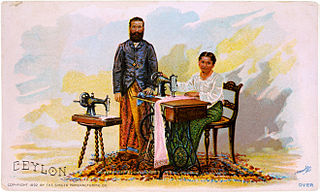
Ceylon, 1893
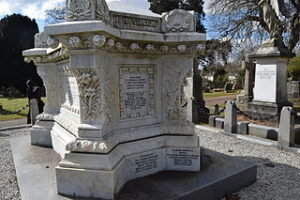
As his success grew, so did Singer’s large lifestyle. I’ve read reports that Singer drove a yellow and black vehicle of his own design drawn by up to nine horses, with a small band to provide music. The vehicle had seating for 31, beds for the children, and a water closet. In his personal life, Singer married his first wife when he was age 29. After the couple had two children, he left her and moved to Paris where, in 1863, he married Isabella Boyer and had six more children. Singer later left Paris and his family to move to England where he died in 1875. At that time, the company was turning a profit of $22 million annually.
The Singer Manufacturing Company Continued
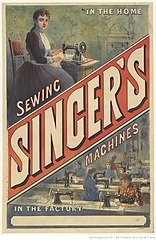
In 1889 The Singer Manufacturing Company demonstrated the first electric sewing machine at the Philadelphia Electric Exhibition. Mass production of the electric machine began in 1910, but not everyone had electricity or wanted to give up the treadle machines which remained popular in early 20th century America.
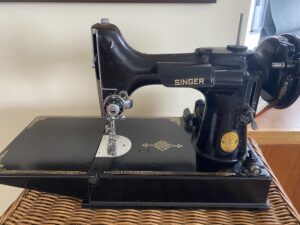
During the 1930s, The Singer Manufacturing Company introduced a lightweight portable machine: The Singer Featherweight Model 221. Weighing 11 pounds, the machine was a bit heavy for a “feather”, but with its cast aluminum body, it was far lighter than previous portable machines. It also came with a nifty carring case. Priced at about $150 during the 1950s [equivalent to $2000 in 2016], the small machines were a hit with American women.
I learned how to sew using the Singer Featherweight on the right, at a time when the company was introducing machines that could do zig-zag stitching. As a teen-ager, I felt hopelessly behind. But today, I can sew a straight stitch [forward and back] with the best of “them.”
Mixed Blessing
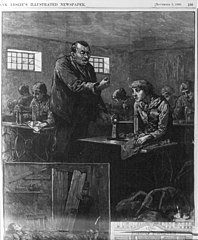
Though the sewing machine reduced the labor of producing clothing, it was not entirely a blessing to women. The clothing industry was founded on reliable machines, cheap female labor, and sweatshop factory conditions that persist today.
🪡 🪡 🪡
Illustrations
Advertisement. Singer Sewing Machine. 1904.
Elias Howe 1867.
Elias Howe Sewing Machine.
Isaac Merrit Singer. 1869.
Singer Sewing Machine 1851.
Singer Treadle Sewing Machine.
Sheet Music. The Merry Singer.
Advertisement Cards for Singer Sewing. 1892: Portugal, Zululand, Ceylon.
Advertisement. Singer Sewing Machines. 1892.
Singer Family Tomb at Torquay. Attribution: southdevonplayers.
Author’s Singer Featherweight Machine. By Author.
Boss Waving Fist at Female Employee. 1888.
Randy Alfred. “Sept. 10, 1846.” Wired. Sept. 10, 2009.
Wendy Skinner. “Then and Now: Making History One Stitch at a Time.” Ithaca Journal. July 15, 2015.

Sandra Wagner-Wright holds the doctoral degree in history and taught women’s and global history at the University of Hawai`i. Sandra travels for her research, most recently to Salem, Massachusetts, the setting of her new Salem Stories series. She also enjoys traveling for new experiences. Recent trips include Antarctica and a river cruise on the Rhine from Amsterdam to Basel.
Sandra particularly likes writing about strong women who make a difference. She lives in Hilo, Hawai`i with her family and writes a blog relating to history, travel, and the idiosyncrasies of life.

